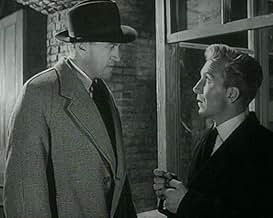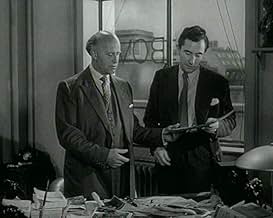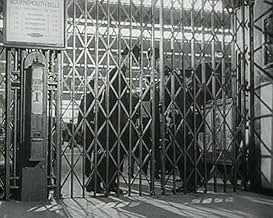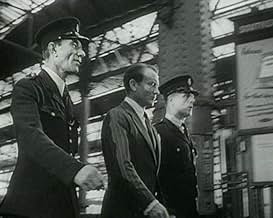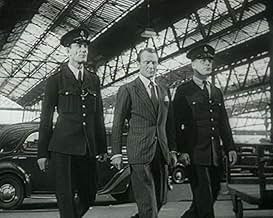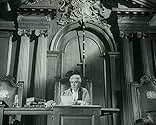CALIFICACIÓN DE IMDb
7.0/10
1.4 k
TU CALIFICACIÓN
Agrega una trama en tu idiomaReleased from prison after twelve years, a wrongfully convicted British man seeks revenge on the witnesses who lied at his trial.Released from prison after twelve years, a wrongfully convicted British man seeks revenge on the witnesses who lied at his trial.Released from prison after twelve years, a wrongfully convicted British man seeks revenge on the witnesses who lied at his trial.
- Dirección
- Guionistas
- Elenco
Michael Martin Harvey
- Jackson
- (as Michael Martin-Harvey)
- Dirección
- Guionistas
- Todo el elenco y el equipo
- Producción, taquilla y más en IMDbPro
Opiniones destacadas
Robert Hamer was not a prolific director; only around a dozen films are credited to him, and because of his serious alcohol problem there is some doubt as to the extent to which he was responsible for some of those, especially his final film, "School for Scoundrels". His career has been described as "the most serious miscarriage of talent in the postwar British cinema", yet during that relatively brief career he was responsible for some of the best British films of the forties and fifties. He is today best remembered for that brilliant Ealing comedy, "Kind Hearts and Coronets", but was capable of producing serious movies as well as comedies; his "It Always Rains on Sunday", for example, is a crime thriller showing the influence of the film noir style.
With "The Long Memory" from 1952, Hamer moves even closer in the direction of noir. The plot, based on a novel by Howard Clewes, owes something to Dumas' "The Count of Monte Cristo". A young man is sentenced to imprisonment for a crime he did not commit. Upon his release, he sets out to get revenge upon those responsible for his wrongful conviction, including his treacherous fiancée. The hero, Philip Davidson spends 12 years in prison after being wrongly convicted for murder, a conviction procured by perjured evidence given by his fiancée Fay, her father Captain Driver and a man named Tim Pewsey. Fay's motive for perjuring herself was to protect her elderly father, who had become mixed up in a criminal enterprise with Pewsey and another man named Boyd, the actual murderer.
Some purists maintain that film noir was an exclusively American genre, but I have never concurred with that opinion, as there were also a number of British films (and indeed French ones such as "Les Diaboliques") which share the characteristics of noir, and this is one of them. One of the classic noir features is the morally ambiguous lone male hero, and John Mills' Davidson is certainly a character of that type; had this been a Hollywood film he could have been played by Bogart or Mitchum. Although he has been the victim of a grave injustice, and in that sense has a claim on our sympathy, his experiences have made him, in many ways, an unsympathetic character, vindictive and unsociable. After his release he goes to live in a disused barge on the marshes, a dwelling reminiscent of Richard Widmark's wooden shack by the riverside in a great American noir, "Pickup on South Street". Davidson's closest friend is another of life's victims, wartime refugee named Ilse, and he has other allies in his fight to clear his name, including Craig, a journalist, and Superintendent Bob Lowther, a policeman who believes that a miscarriage of justice may have occurred. Lowther's position, however, is made difficult by the fact that he is married to Fay, the woman whose lies were responsible for Davidson's conviction.
Other noir characteristics present in this film include dramatic, expressionistic black-and-white photography and a gritty urban setting, with the dingy backstreets of Gravesend (a riverside port east of London and not normally regarded as an important cinematic location) here fulfilling the role which in an American noir would played by Los Angeles or New York. The setting is not, however, exclusively urban; many scenes were shot on the North Kent Marshes, the area around Gravesend and Rochester immortalised by Dickens in "Great Expectations". This marshland landscape around the Thames and Medway Estuaries, an area which I know well, is not conventionally beautiful in the way in which, say, the Lake District or the Cotswolds are beautiful. Indeed, it can often be bleak and forbidding, but it is also powerfully atmospheric. It makes a fitting setting for this tale of crime and revenge and gives the film has a strong sense of place. The film ends with justice being done, but here too there is a note of doubt and uncertainty; it is not, for example, clear whether Lowther's marriage to Fay can survive the revelations about her past.
The most famous British noir is probably "The Third Man", a British-made film even though it is set in Vienna. "The Long Memory" is less well-known, but with a strong performance from Mills in the leading role, its powerful storyline and Hamer's atmospheric direction I would place it in the same class as Carol Reed's masterpiece. 9/10
With "The Long Memory" from 1952, Hamer moves even closer in the direction of noir. The plot, based on a novel by Howard Clewes, owes something to Dumas' "The Count of Monte Cristo". A young man is sentenced to imprisonment for a crime he did not commit. Upon his release, he sets out to get revenge upon those responsible for his wrongful conviction, including his treacherous fiancée. The hero, Philip Davidson spends 12 years in prison after being wrongly convicted for murder, a conviction procured by perjured evidence given by his fiancée Fay, her father Captain Driver and a man named Tim Pewsey. Fay's motive for perjuring herself was to protect her elderly father, who had become mixed up in a criminal enterprise with Pewsey and another man named Boyd, the actual murderer.
Some purists maintain that film noir was an exclusively American genre, but I have never concurred with that opinion, as there were also a number of British films (and indeed French ones such as "Les Diaboliques") which share the characteristics of noir, and this is one of them. One of the classic noir features is the morally ambiguous lone male hero, and John Mills' Davidson is certainly a character of that type; had this been a Hollywood film he could have been played by Bogart or Mitchum. Although he has been the victim of a grave injustice, and in that sense has a claim on our sympathy, his experiences have made him, in many ways, an unsympathetic character, vindictive and unsociable. After his release he goes to live in a disused barge on the marshes, a dwelling reminiscent of Richard Widmark's wooden shack by the riverside in a great American noir, "Pickup on South Street". Davidson's closest friend is another of life's victims, wartime refugee named Ilse, and he has other allies in his fight to clear his name, including Craig, a journalist, and Superintendent Bob Lowther, a policeman who believes that a miscarriage of justice may have occurred. Lowther's position, however, is made difficult by the fact that he is married to Fay, the woman whose lies were responsible for Davidson's conviction.
Other noir characteristics present in this film include dramatic, expressionistic black-and-white photography and a gritty urban setting, with the dingy backstreets of Gravesend (a riverside port east of London and not normally regarded as an important cinematic location) here fulfilling the role which in an American noir would played by Los Angeles or New York. The setting is not, however, exclusively urban; many scenes were shot on the North Kent Marshes, the area around Gravesend and Rochester immortalised by Dickens in "Great Expectations". This marshland landscape around the Thames and Medway Estuaries, an area which I know well, is not conventionally beautiful in the way in which, say, the Lake District or the Cotswolds are beautiful. Indeed, it can often be bleak and forbidding, but it is also powerfully atmospheric. It makes a fitting setting for this tale of crime and revenge and gives the film has a strong sense of place. The film ends with justice being done, but here too there is a note of doubt and uncertainty; it is not, for example, clear whether Lowther's marriage to Fay can survive the revelations about her past.
The most famous British noir is probably "The Third Man", a British-made film even though it is set in Vienna. "The Long Memory" is less well-known, but with a strong performance from Mills in the leading role, its powerful storyline and Hamer's atmospheric direction I would place it in the same class as Carol Reed's masterpiece. 9/10
I caught this on film four a couple of weeks ago and thought it was excellent. It is a painful story at times, watching John mill's former lover grappling with her guilt, often physically is portrayed with undignified desperation. Her husband, the investigating officer quietly torn apart by the realisation of his own hand in a miscarriage of justice and his subsequently crumbling home and professional life. John Mills' constant struggle to realise a revenge that has torn him throughout his years in prison and an inability to exact that revenge. He shows, without being sanctimonious, how damaging and unfulfilled revenge is and the characters around him prove that redemption is always hard won.
I am a fan of British cinema but I must admit that there a couple of genres that Hollywood does much better, particularly musicals but also film noir. In fact I didn't know that the British had attempted noir until I saw Robert Hamer's `The Long Memory' which makes a fair fist of it while perhaps finally lacking the courage of it's convictions. The doomed characters, the shadowy, desolate streetscapes and of course the femme fatale are all there and John Mills convinces as a broken man at liberty after serving 12 years for a crime he didn't commit.
John McCallum and Elizabeth Sellars are perhaps a little too restrained in the English way (I know McCallum is Australian) but John Slater makes an impression as a punch-drunk ex-boxer. Incidentally, Slater's make-up reminded me irresistibly of Mills' Oscar-winning turn in ` Ryan's Daughter' years later.
In this solid, involving drama Mills has revenge in mind, Geoffrey Keene is an ethical reporter (an oxymoron?) looking for a story and nothing turns out as expected.
Well worth seeing.
John McCallum and Elizabeth Sellars are perhaps a little too restrained in the English way (I know McCallum is Australian) but John Slater makes an impression as a punch-drunk ex-boxer. Incidentally, Slater's make-up reminded me irresistibly of Mills' Oscar-winning turn in ` Ryan's Daughter' years later.
In this solid, involving drama Mills has revenge in mind, Geoffrey Keene is an ethical reporter (an oxymoron?) looking for a story and nothing turns out as expected.
Well worth seeing.
This is an excellent British film, which has managed to pass the test of time, and still stands today as an absorbing & well executed piece of work. The story line is strong, and the locations are particularly memorable, especially the bleak & foreboding Kent coastline which adds significantly to the brooding atmosphere. The performances are uniformly excellent, with the sole exception of Elizabeth Sellars who barely changes expression throughout. John Mills gives one of his most intense performances in the lead role, and demonstrates once again what an extremely fine actor he always was. The direction & editing are first class, and the film never falters in holding the attention. For fans of the genre, this is not to be missed.
Crime, punishment, revenge, love and redemption are the big themes of this short movie. The moral bleakness surrounding John Mills, as a man unjustly jailed and now seeking revenge, is reflected in the powerfully stark black and white landscape images which accompany the action. But the issues are far from black and white - the guilty, the innocent and even the investigating policeman are all caught up in the moral dilemmas explored by this clever and thoughtful script. Ultimately all the characters learn that punishment can take many forms, in a conclusion which is both gripping and surprising.
It's not light entertainment, but don't be put off by its serious tone and gritty subject matter. Once seen, this movie will live long in your memory.
It's not light entertainment, but don't be put off by its serious tone and gritty subject matter. Once seen, this movie will live long in your memory.
¿Sabías que…?
- TriviaMany of the houses shown in this movie were demolished soon afterwards.
- ErroresAfter Craig is pushed face first into a muddy hold by Davidson he is next seen with a dirty overcoat but his face and hair are completely spotless.
Selecciones populares
Inicia sesión para calificar y agrega a la lista de videos para obtener recomendaciones personalizadas
- How long is The Long Memory?Con tecnología de Alexa
Detalles
- Fecha de lanzamiento
- País de origen
- Idioma
- También se conoce como
- Dugo sećanje
- Locaciones de filmación
- Gravesend, Kent, Inglaterra, Reino Unido(Queen Street and Granby Road were locations for the two Tim Pewsey residences.)
- Productoras
- Ver más créditos de la compañía en IMDbPro
- Tiempo de ejecución1 hora 36 minutos
- Color
- Relación de aspecto
- 1.33 : 1
Contribuir a esta página
Sugiere una edición o agrega el contenido que falta

Principales brechas de datos
By what name was The Long Memory (1953) officially released in India in English?
Responda

